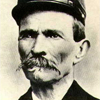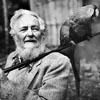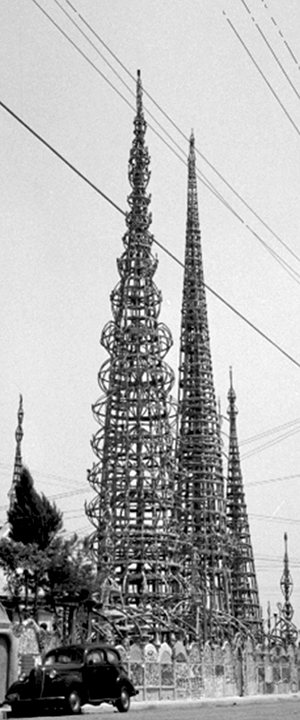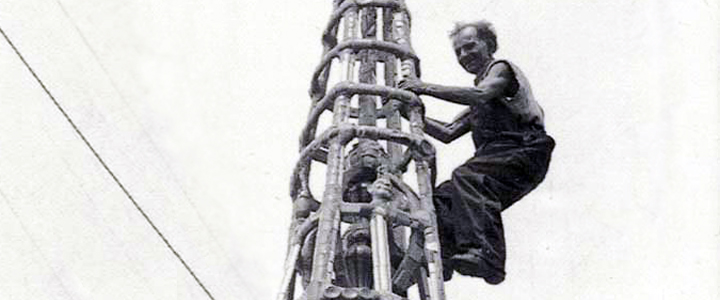Scaling The Heights Of Outsider Art: Watts TowerS
|
The Watts Towers are series of 17 interconnected sculptural towers built by Italian immigrant Sabato ("Simon") Rodia, over a period of 33 years, in the Watts neighbourhood of Los Angeles, California. Rodia emigrated to the United States, at the turn of the century, and after landing on the east coast, he worked his way across country, eventually finding work in the quarries and railroad yards of California. In 1921 he purchased a triangular-shaped lot at 1761-1765 107th Street in Los Angeles and began to construct his masterpiece, which he called "Nuestro Pueblo" (meaning "our town"). When he was asked why he made the towers, he answered "I wanted to do something big and I did it."
From 1921 until 1954 when he retired and bequeathed the towers to a neighbour, Rodia worked tirelessly on the towers. They are constructed from an armature of steel rebar, wrapped in wire mesh and coated in a concrete mix of Rodia's own creation. Much of the surface of the towers are covered in thousands of pieces of broken ceramic and tiles. As well as bottles, shells, mirrors, and all manner of found objects that Rodia came across during their construction. The towers were built totally by hand, no heavy equipment was used, as over the years they grew organically without any predetermined design. The towers became famous, much to the annoyance of the city authorities, who Rodia butted heads with over his flagrant disregard of planning regulations. |
In 1959 Actor Nicholas King and a film editor William Cartwright bought the plot that the towers were on from the neighbour, in order to preserve them, for $3000. The city authorities still were pursuing the demolition of the towers, but came up against opposition to their plans from around the world. King and Cartwright formed a committee, along with other lovers of the towers, and put pressure on the city authorities to allow the towers to be tested for safety by a civil engineer. In the October of 59, a steel cable was attached to the tower and each was pulled by a crane, with a load meter registering 10,000lbs of pressure being exerted on them. The towers didn't move an inch, which surprised the testing engineers, who noted that the towers were embedded only 2 feet into the ground. And so what have become known as the Watts Towers were allowed to stay, and the remain there to this day, as one of southern California's most important pieces of public art. Eventually being designated a National Historic Landmark in 1990.
The Watts Towers Arts Center was opened in 1970, adjacent to the towers. The center was built and staffed by the non-profit committee. In 1975, the committee, which had persevered the unique work of art for 16 years, gave the towers and adjoining Arts Center to the City of Los Angeles. The Arts Center provides a cultural hub for the Watts community, with rotating arts exhibitions and classes provided.
|
The Center's Charles Mingus Youth Arts Center holds art classes, for youth and Special Needs adults from the local community and surrounding areas. All of this is built from Rodia's legacy, which is much more than a monumental work of outsider art. The international community and the general public of Los Angeles have elevated the tower to more than a work of art, into a unique monument to the human spirit and the persistence of a singular vision. There's a full length documentary about Rodia, and his towers called I Build A Tower. The documentary celebrates the life of the unique visionary, the man who once simply said, "I build the tower people like, everybody come."
|

From A Single Stone, A Postman Built An Ideal Palace - The visionary outsider artist and postman, Ferdinand Chavel, who spent 33 years building his ideal palace, Le Palais idéal in France.
|

Las Pozas: The Surrealist Xanadu Of Edward James - Deep in the rainforests of Mexico exists a bizarre towering surrealist sculpture garden built by an eccentric Englishman.
|



